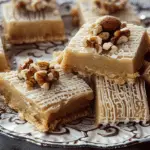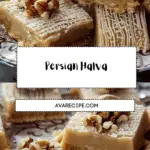Persian Halva
Persian Halva is a traditional Iranian dessert known for its rich, dense texture and aromatic flavors of saffron and rosewater. This sweet confection is often prepared during special occasions and religious ceremonies, offering a comforting taste that pairs wonderfully with tea or coffee.
Why You’ll Love This Recipe
- Aromatic Flavors: The combination of saffron and rosewater provides a unique and fragrant taste that is quintessentially Persian.
- Simple Ingredients: Made with common pantry staples like flour, sugar, and butter, making it accessible and easy to prepare.
- Versatile Serving Options: Enjoy it warm or at room temperature, plain or garnished with nuts for added texture.
Ingredients
(Tip: You’ll find the full list of ingredients and measurements in the recipe card below.)
- White sugar
- Water
- Rosewater
- Saffron threads
- Unsalted butter
- All-purpose flour
Directions
- Prepare the Syrup: In a saucepan, combine sugar and water; bring to a boil, stirring constantly until the sugar dissolves (about 5 minutes). Stir in rosewater and saffron, cover, and remove from heat.
- Toast the Flour: In a separate large saucepan over low heat, melt the butter. Stir in the flour to form a smooth paste. Continue cooking, stirring often, until the paste turns golden (5 to 10 minutes).
- Combine and Cook: Gradually pour the syrup into the flour mixture, stirring continuously until fully absorbed and the halva thickens.
- Serve: Transfer the halva onto a serving platter, flattening it with the back of a spoon. Let it cool slightly before cutting into wedges. Serve warm or at room temperature.
Servings and Timing
- Servings: Approximately 8 servings.
- Preparation Time: 10 minutes.
- Cooking Time: 10 minutes.
- Additional Time: 1 hour (cooling).
- Total Time: 1 hour 20 minutes.
Variations
- Nut Garnish: Sprinkle chopped pistachios or slivered almonds on top for added crunch and flavor.
- Spices: Incorporate ground cardamom into the syrup for an extra layer of aroma.
- Flour Types: Substitute part of the all-purpose flour with whole wheat flour for a nuttier taste.
Storage/Reheating
- Storage: Store leftover halva in an airtight container at room temperature for up to 3 days.
- Reheating: Halva can be enjoyed at room temperature or slightly warmed. To warm, microwave for a few seconds until just softened.
FAQs
What is Persian Halva made of?
Persian Halva is primarily made from flour, butter, sugar, rosewater, and saffron, resulting in a sweet, dense confection.
Can I use margarine instead of butter?
Yes, margarine can be used as a substitute for butter; however, it may slightly alter the flavor.
Is saffron necessary for this recipe?
Saffron provides a distinctive color and aroma, but if unavailable, you can omit it or use turmeric for color, keeping in mind it will change the flavor profile.
How should I serve Persian Halva?
It can be served warm or at room temperature, often garnished with nuts, and pairs well with tea or coffee.
Can I prepare halva in advance?
Yes, halva can be made ahead of time and stored at room temperature for a couple of days.
Why is my halva crumbly?
Crumbly halva may result from overcooking the flour or not adding enough syrup. Ensure the flour is cooked until golden but not dry, and the syrup is fully absorbed.
Can I add other flavors to halva?
Certainly! Adding spices like cardamom or cinnamon can enhance the flavor.
Is Persian Halva gluten-free?
Traditional Persian Halva uses wheat flour and is not gluten-free. For a gluten-free version, alternative flours like rice flour can be experimented with, though results may vary.
How long does it take to make halva?
The active preparation and cooking time is about 20 minutes, with additional time for cooling.
What occasions is halva traditionally made for?
In Iranian culture, halva is often prepared for religious ceremonies, funerals, and memorials, but it can also be enjoyed as a regular dessert.
Conclusion
Persian Halva is a delightful dessert that showcases the rich flavors of Iranian cuisine. Its simplicity in ingredients combined with the aromatic notes of saffron and rosewater makes it a unique treat. Whether for a special occasion or a sweet craving, this halva offers a comforting and flavorful experience. Enjoy it with a warm cup of tea and share this traditional delicacy with friends and family.
- Prep Time: 10 minutes
- Cook Time: 10 minutes
- Total Time: 1 hour 20 minutes
- Yield: 8 servings
- Category: Dessert
- Method: Stovetop
- Cuisine: Middle Eastern
- Diet: Vegetarian
Ingredients
-
For the Syrup:
- 1 cup white sugar
- 1 cup water
- 2 tablespoons rosewater
- ½ teaspoon saffron threads (dissolved in 1 tablespoon warm water)
-
For the Halva:
- ½ cup unsalted butter (or ghee)
- 1 cup all-purpose flour
Instructions
-
-
Prepare the Syrup:
- In a saucepan over medium heat, combine sugar and water. Stir continuously until the sugar dissolves.
- Add rosewater and saffron mixture, stir well, cover, and remove from heat.
-
Toast the Flour:
- In a separate pan, melt the butter over low heat.
- Gradually stir in the flour, mixing continuously to form a smooth paste.
- Cook for 5-10 minutes, stirring constantly, until the flour turns golden and aromatic.
-
Combine and Cook:
- Slowly pour the prepared syrup into the flour mixture, stirring continuously.
- Cook until the mixture thickens and forms a smooth, glossy halva.
-
Shape and Serve:
- Transfer the halva onto a serving plate, smoothing it with the back of a spoon.
- Let it cool slightly before cutting into pieces. Serve warm or at room temperature.
-
Notes
- Variations: Add ground cardamom for extra aroma or garnish with chopped pistachios.
- Storage: Store in an airtight container at room temperature for up to 3 days.
- Reheating: Enjoy at room temperature or warm slightly in the microwave.
Find it online: https://avarecipe.com/persian-halva/

